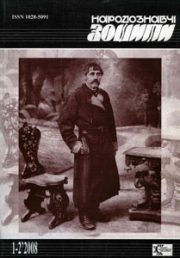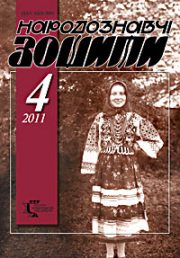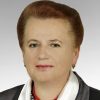The Ethnology Notebooks. 2025. № 4 (184), 1004—1010
UDK929:398(091) М. Коцюбинський, Б. Грінченко
DOI DOI https://doi.org/10.15407/nz2025.04.1004
ESSAY ON THE SCIENTIFIC COOPERATION OF MYKHAYL KOTSIUBYNSKY AND BORYS GRINTCHENKO
SHALAK Oksana
- ORCID ID: https://orcid.org/0000-0002-8275-6703
- Cand. Sc. Of Philological Studies
- Senior Research Officer,
- Institute of Biographical Studies
- National Library of Ukraine named after V.I. Vernadskyi,
- Department of theory and methods of biobibliography,
- 62, Volodymyrska vul, 125 room, 01033, Kyiv, Ukraine,
- Contacts: e-mail: shalak@ukr.net
Abstract. The relevance of the article is due to the need to comprehend the significance of the cooperation in the field of folklore studies of Mykhaylo Kotsiubynsky (1864—1913) and Borys Grintchenko (1863—1910), to analyze their scientific principles of recording and publishing folklore.
The writers’ scientific relationships cover several periods in their activities; they are important not only for the detailed reconstruction of their biographies, but also for the history of Ukrainian folklore studies and the formation of its scientific foundations.
The purpose of the study is to reveal the peculiarities of M. Kotsiubynsky’s collecting practice and the process of preparing his folklore collection for publication, to analyze B. Grinchenko’s editorial principles and his contribution to the formation of the scientific foundations of Ukrainian folk art science.
The scientific novelty lies in the attempt to determine the working methods of two writers who not only used folklore plots, reinterpreted them, but also collected and published scientifically reliable primary folklore material themselves. The problem of the genre collection of folklore by M. Kotsiubynsky (folk tales, songs, proverbs and sayings) is raised, the principles of B. Grinchenko during the systematization and arrangement of folklore collections of various collectors, his principles of reproducing not only the dialectal features of the language, but also the speech features of the bearers of folklore are expanded.
The methodological basis of the study was the comparative-historical and the method of complex typological analysis of phenomena and figures in the history of Ukrainian folklore studies.
Keywords: Mykhailo Kotsiubynskyi, Borys Grinchenko, principles of fixation, editorial principles, passport, performer.
Received 18.07.2025
REFERENCES
- Bukatevych, N., & Doroshevych, Ol. (Ed.). (1931). Ukrainian folklore in the work of Kotsyubynsky. Іn: Ol. Doroshevych. Kotsyubynsky (Vol. 1, pp. 191—223.). Kharkiv: Literatura i mystetstvo [in Ukrainian].
- Kozub, S., & Doroshevych, Ol. (Ed.). (1931). Folklore records of Kotsyubynsky. Іn: Ol. Doroshevych. Kotsyubynsky (Vol. 1, pp. 272—285). Kharkiv: Literatura i mystetstvo [in Ukrainian].
- Hrytsiuta, M.S. (1958). M. Kotsyubinsky and folk creativity. Kyiv: Vyd-vo AN URSR [in Ukrainian].
- Buchko, N.O. (1959). From M.M. Kotsyubynskyi’s interests in folklore and ethnography. Folk art and ethnography, 3, 74—77 [in Ukrainian].
- Kozar, L. (2006, June). Collectors of Podil folklore — correspondents of Borys Grinchenko. In: Podil folklore in collection and research: theses of the international scientific and practical conference dedicated to the 105th anniversary of the birth of H. Tantsiurа (Pp. 272—285). Vinnytsia: Nova knyha [in Ukrainian].
- Yesypenko, D. (2015). Colleagues, opponents: a few remarks about the personal and creative contacts of Borys Grinchenko and Mykhailo Kotsyubynsky. Studia ukrainica posnaniensia (Vol. III, pp. 381—386) [in Ukrainian].
- Koverdynsky, Vsevolod Omelianovych. M. Kotsyubynsky at the Shargorod school. Memories of M.M. Kotsyubinsky. With a foreword by Ivan Lyuty (start. 20th century). Archive of the Institute of Manuscript of Vernadsky National Library of Ukraine. F. 10. Od. save 17485 [in Ukrainian].
- Attitude of the Yampol police officer dated October 3, 1891. About the arrival of M. Kotsyubinsky on September 11 in the village. Lopatintsy. State Archive of Vinnytsia оblast. F. Д-220. Desc. 7. Case. 95 [in Russian].
- Grinchenko, B.D. (Ed.). (1901). From the mouth of the people: Little Russian stories, fairy tales, etc. Chernіgov [in Ukrainian].
- Where did the lordship come from (story). Recorded by M.M. Kotsyubynskyi in the village Stadnitsy, Podilska rovince, in 1890. Archive of the Institute of Manuscript of Vernadsky National Library of Ukraine. F. 170. Od. save 634 [in Ukrainian].
- Records of A. Dyminsky on Podilla in the middle of the 19th century (folkloric prose). Archival Scientific Funds of Manuscripts and Audio-Recordings of the M. Rylskyi Institute of Art Studies, Folkloristics and Ethnology of the NAS of Ukraine. F. 1-дод. 5/507 [in Ukrainian].
- Grinchenko, B.D. Proverbs and sayings recorded by various collectors. Copies. Archival Scientific Funds of Manuscripts and Audio-Recordings of the M. Rylskyi Institute of Art Studies, Folkloristics and Ethnology of the NAS of Ukraine. F. 1-К 2/47 [in Ukrainian].
- Grinchenko, B.D. (Ed.). (1899). Ethnographic materials collected in Chernigiv and neighboring provinces (Vol. 3: Songs). Chernіgiv [in Ukrainian].






